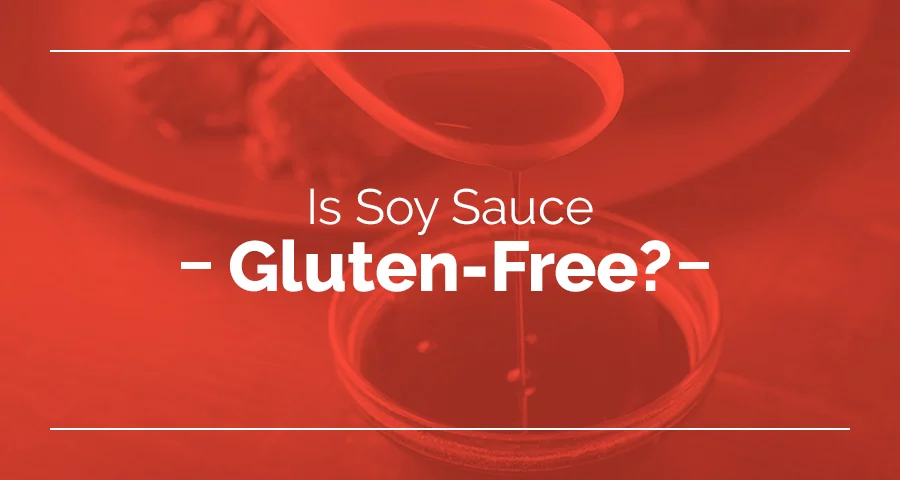What if you could get all the salty umami flavor of soy sauce while still sticking to a gluten-free diet? With a reliable gluten-free soy sauce, you can add more complex layers of savory flavor to your dishes without risking any of the symptoms that come with gluten intolerance. Although not every type of soy sauce will meet your gluten-free dietary needs, you still have plenty of options for getting that rich umami taste without the gluten.
This ultimate guide to gluten-free soy sauce will go over what gluten is, the different soy sauces available to you, how to choose a gluten-free soy sauce and some gluten-free soy sauce alternatives to test out. If you’re ready to sprinkle some extra flavor into your gluten-free diet, here’s what you need to know about gluten-free soy sauce.
Table of Contents
What Is Gluten?
Types of Soy Sauce
How to Choose a Gluten-Free Soy Sauce
Gluten-Free Soy Sauce Alternatives
Gluten-Free Tamari Soy Sauce From SAN-J
What Is Gluten?
You’ve likely heard of gluten and gluten-free diets, but what exactly is gluten? And why does it seem to be in such a wide variety of foods?

What Does “Gluten” Mean?
The term “gluten” refers to the family of proteins found in grains, such as wheat, barley, rye and spelt. There can be hundreds of distinct proteins within the mixture, but the proteins are all related to each other and collectively referred to as gluten. The main two proteins in this gluten family of proteins are called gluten and gliadin.
Out of all the grains that contain gluten, wheat is by far the most common because it is used as the binding ingredient — often in the form of flour — in many foods. When flour gets combined with water, the proteins in gluten come together to form one cohesive network with a sticky consistency similar to glue. The name gluten actually comes from this glue-like characteristic.
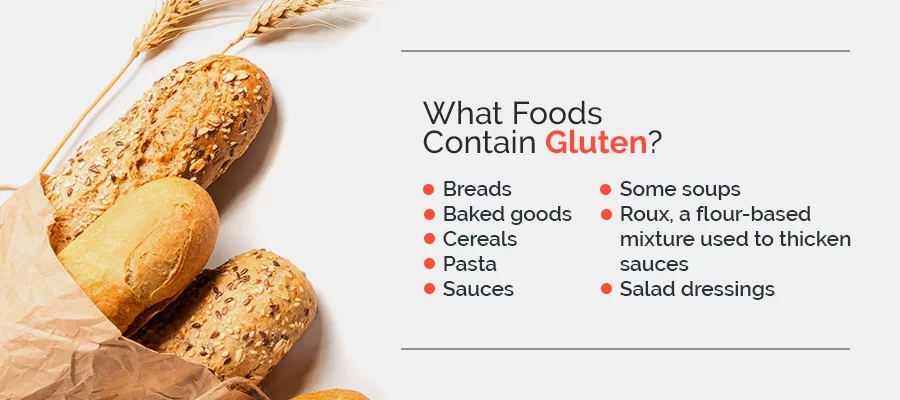
What Foods Contain Gluten?
Thanks to its glue-like binding abilities, gluten is used in bread dough to make it more elastic and allow the bread to rise as it bakes. By holding the dough together, gluten helps the loaf maintain its shape. Gluten is also what gives bread the chewy texture that makes it so satisfying and delicious.
Because gluten is so useful for forming dough and binding foods together, it can be found in many varieties of food. Oftentimes, gluten is even in unexpected foods like some types of candies and chips. Carefully reading food labels will help you identify whether a food contains gluten so that you can avoid it if necessary.
While gluten can sneak into many foods, there are three main sources of gluten — wheat, barley and rye. Paying attention to foods made with these grains is the easiest way to be aware of whether or not a food contains gluten.
These are foods that typically contain wheat:
- Breads
- Baked goods
- Cereals
- Pasta
- Sauces
- Some soups
- Roux, a flour-based mixture used to thicken sauces
- Salad dressings
As a popular grain for sweetening foods and beverages, barley is most often found in these products:
- Malt, such as malted milk and milkshakes or malted barley flour
- Beer
- Brewer’s yeast
- Soups
- Food coloring
Rye is not quite as common as wheat or barley. There are usually only a few foods that contain rye:
- Rye breads, such as pumpernickel
- Rye beer
- Some cereals
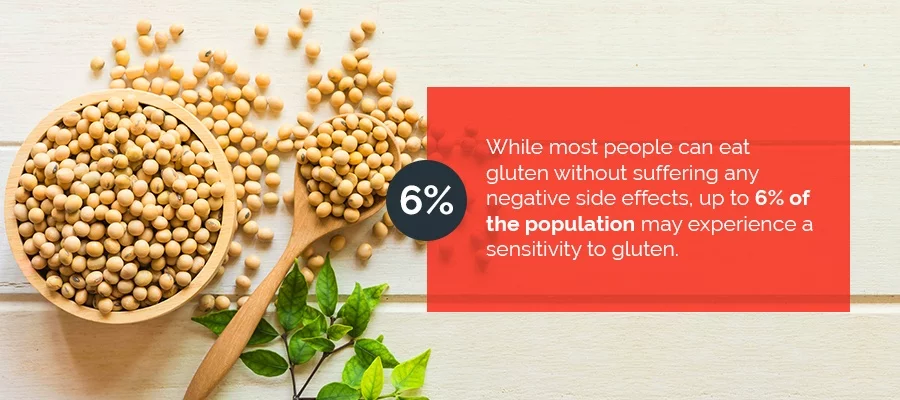
What’s the Problem With Gluten?
While most people can eat gluten without suffering any negative side effects, up to 6% of the population may experience a sensitivity to gluten. Even for some people without a diagnosis specific to gluten sensitivity, consuming gluten can sometimes cause symptoms by aggravating other health conditions, such as irritable bowel syndrome (IBS).
Despite the phrase “gluten sensitivity,” gliadin is actually the cause behind most of the adverse health effects eating gluten can have on some people, not gluten itself. The peptide sequences found in gliadin can disrupt the gastrointestinal tract and cause extreme discomfort because they are highly resistant to the digestive process.
A sensitivity to gluten can take on a variety of different forms and cause a range of symptoms. The health condition most commonly associated with gluten sensitivity is celiac disease. Celiac disease, also known as coeliac disease, is the most severe type of gluten intolerance that affects about one out of every 133 Americans, or 1% of the population.
Celiac disease is an autoimmune disorder that occurs when the body views gluten as a foreign invader and signals for the immune system to attack the gluten. When attacking the gluten as a foreign invader, the body also attacks the lining of the gut, which can severely damage the gut wall and lead to digestive issues, nutrient deficiencies, anemia and an increased risk of developing diseases.
Most often, celiac disease causes these symptoms:
- Digestive discomfort
- Damage to the tissue in the small intestines
- Diarrhea or constipation
- Bloating
- Headaches and tiredness
- Rashes on the skin
- Depression
- Unexplained weight loss
Although celiac disease is usually recognized by the digestive symptoms it causes, some people with celiac disease do not experience any digestive issues. Instead, some who have celiac disease might only feel fatigued or get unexplained rashes. For this reason, diagnosing celiac disease can be difficult.
On the other hand, people who do not test positive for celiac disease may still respond negatively to gluten. This condition is known as non-celiac gluten sensitivity. As a fairly new health concern, there is no clear definition of non-celiac gluten sensitivity yet, but medical professionals typically make the diagnosis when a patient’s negative reaction to gluten can’t be attributed to celiac disease.
Aside from celiac disease and non-gluten sensitivity, a wheat allergy can be the root cause behind digestive issues and other symptoms after eating gluten. Although a wheat allergy can be easily confused with celiac disease, a wheat allergy involves separate components of the immune system and affects only about 1% of the population.
As with other food allergies, a wheat allergy includes an immune system response. During a wheat allergy reaction, the immune system mistakes a protein in wheat for being dangerous to the body’s health and creates an antibody to the protein. This triggers an immune system response that may cause symptoms like congestion or trouble breathing.
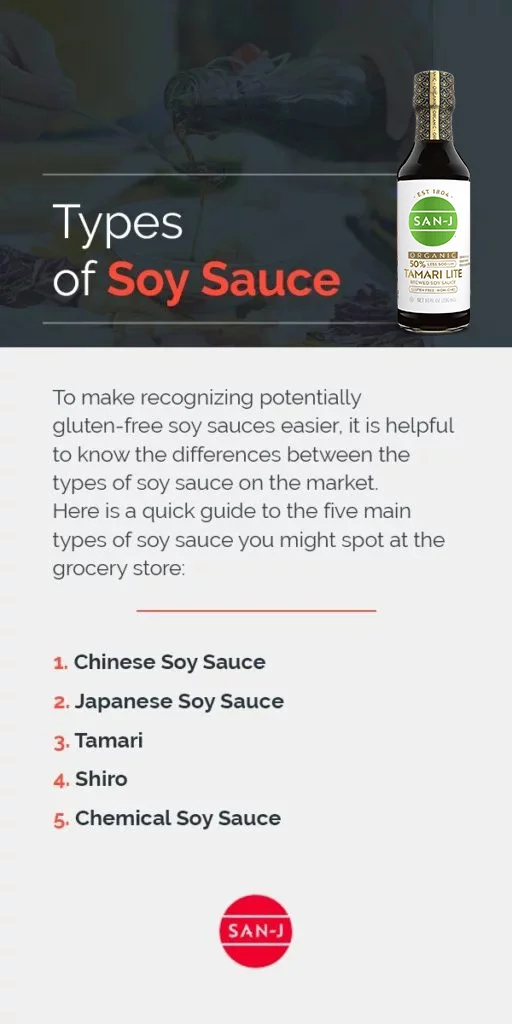
Types of Soy Sauce
Despite its name, soy sauce is not made solely from soy in many cases. Instead, soy sauce is usually made with wheat, soybeans, salt and water, which means most soy sauces contain gluten. However, some soy sauces are gluten-free, making these varieties an option even if you’re on a gluten-free diet.
If you need to stick to a gluten-free diet, however, be sure to read the bottle’s label thoroughly before dousing your meal in soy sauce. To make recognizing potentially gluten-free soy sauces easier, it is helpful to know the differences between the types of soy sauce on the market.
Here is a quick guide to the four main types of soy sauce you might spot at the grocery store:
1. Chinese Soy Sauce
Soy sauce was originally created in ancient China by pressing fermented soybeans to produce a pure bean sauce. The sauce was added to dishes to preserve them and enhance their flavors while cooking. Nowadays, Chinese soy sauce often contains wheat as well as soybeans, but it is still the most common cooking sauce used in Chinese cuisine.
Typically, Chinese soy sauce is light, thin and salty. If you’re following a Chinese recipe that calls for soy sauce, you can assume it means light soy sauce. You could also use a double-fermented light soy sauce, which will provide a mellower tone and give the dish a more complex flavor.
There are dark and double dark varieties of Chinese soy sauce as well that are darker in color and have a thicker texture. Darker Chinese soy sauces are also less salty than light soy sauces as well as a bit sweeter. Due to a longer fermentation period and the addition of molasses or sugar, dark Chinese soy sauces have a sweet-salty flavor along with a viscous texture.
While light Chinese soy sauces are often used for dipping foods like dumplings, darker soy sauces are solely used for cooking. You can sprinkle in some dark soy sauce during the final stages of cooking to bring some extra color and flavor to a dish.
2. Japanese Soy Sauce
Shoyu is the general term for Japanese-style soy sauces. Typically, it is a type called koikuchi soy sauce that is made with both soybeans and wheat to produce a more aromatic flavor. Japanese soy sauce also tends to be lighter and clearer than Chinese soy sauces.
Japanese soy sauce can be categorized by five types. Koikuchi, Usukuchi, Tamari, Saishikomi, and Shiro. It can be light or dark, and the darker version of Japanese soy sauce is more commonly used than the lighter version. Koikuchi, Tamari, and Saishikomi are the darker types and most of the Japanese-style soy sauces you’ll find at the grocery store will be dark, which has a deeper color and taste. Dark Japanese soy sauce is a great all-purpose soy sauce that you can use in marinades and basting sauces, as well as for stir-fries and dipping.
Usukuchi and Shiro are the light types of Japanese soy sauce. Although usukuchi soy sauce is lighter in color, it contains more salt than other types of Japanese soy sauce in order to make the fermentation and aging process more gradual and to create a lighter color and aroma. You can substitute light Japanese soy sauce for dark, but you may want to scale back the amount because of the light soy sauce’s more intense flavor.
Shiro means white in Japanese and its color is even lighter than usukuchi. It is made with more wheat and a small amount of soybeans, producing a sweeter flavor and unique aroma. Light Japanese-style soy sauce is a popular choice for seasoning dishes without turning the ingredients a darker color. Use is for clear soups, white-fleshed fish, pickles, and rice crackers .
3. Tamari
Tamari is the origin of Japanese soy sauce. While shoyu (koikuchi soy sauce) is typically brewed with about equal parts soybeans and wheat, Tamari is brewed with all soybeans or only very small amounts of wheat added. Tamari is originally found during miso making process, the dark red paste that comes from cooked and fermented soybeans. Tamari is the protein-rich liquid that accumulated as miso ripens.
Because Tamari has a higher soybean content than other soy sauces, it has a fuller flavor. It also retains flavor when cooked. The rich and well-rounded taste of Tamari makes it a delicious addition to any dish, as well as an excellent dipping sauce. From stir-fries, teriyaki to soups, you can get creative with Tamari.
4. HVP Sauce
A HVP (hydrolyzed vegetable protein) sauce is chemically made by breaking down soy protein and mixing it with other flavorings to produce a product that resembles soy sauce. During this process, the soy protein is hydrolyzed — or broken down — into amino acids and blended with sugars, salt, coloring agents like corn syrup and caramel, water and chemicals to neutralize the concoction.
Although chemical soy sauce can be used for cooking or dipping, we recommend sticking with traditionally fermented soy sauces. Also HVP soy sauce can contain a range of artificial preservatives so check ingredients on the label.
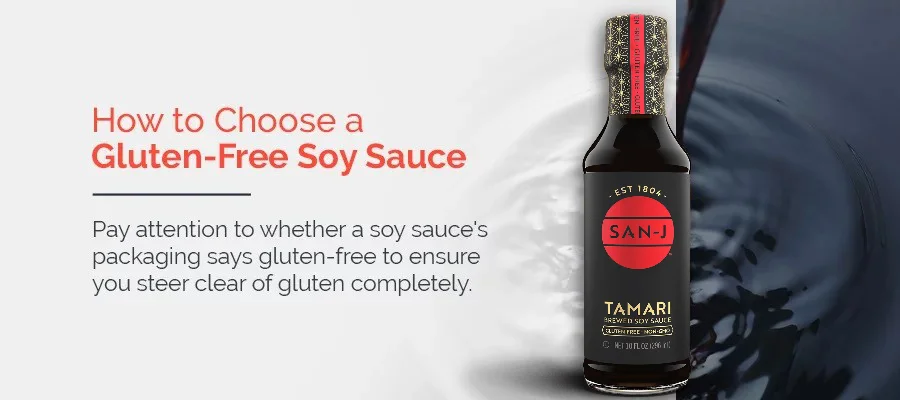
How to Choose a Gluten-Free Soy Sauce
As you may have noticed while reading through the various types of soy sauce, most soy sauces contain wheat, which means they contain gluten. Soy sauces made from soybeans and crushed wheat will naturally have traces of gluten from the wheat. Pay attention to whether a soy sauce’s packaging says gluten-free to ensure you steer clear of gluten completely.
You can also read the soy sauce’s ingredients list to find out whether it contains grains that have gluten. Even when a soy sauce markets itself as gluten-free, you may want to look over its ingredients just to be sure that it is a wheat-free soy sauce.
If you’re looking for a reliable gluten-free soy sauce, Tamari is your best gluten-free option because many brands of Tamari use only fermented soy during the brewing process. Since it doesn’t include wheat or any other grain, Tamari also doesn’t contain gluten. This sets it apart from other types of soy sauce. Although Tamari is a fairly safe soy sauce option for those on a gluten-free diet. Some tamari brands can contain wheat, so always check the label to make sure it is certified gluten-free.
If you want to be sure you’re getting a gluten-free soy sauce, choose SAN-J Tamari Soy Sauce. While some Tamari brands can use very small amounts of wheat, SAN-J Tamari Soy Sauce is always brewed with 100% soy. It never contains any wheat and it is certified gluten free. The fermentation process we use breaks the soy protein into complex amino acids that give the soy sauce a distinct flavor, rich taste and unique flavor-enhancing abilities.
You can use SAN-J Tamari Soy Sauce just like any other type of soy sauce. Whether you need to marinate meat, stir-fry some rice or dip sushi, you can use Tamari to bring a flavor boost to your cuisine without worrying about adding any gluten to the meal. You can even incorporate SAN-J Tamari Soy Sauce into your favorite stir fry, salad dressing, soup, sauce or casserole recipe to give it a fuller umami flavor.
Gluten-Free Soy Sauce Alternatives
Finding a gluten-free soy sauce alternative that packs just as much flavor and brings just as much complexity to a dish can be a tough task. We’ve made it a bit easier for you by compiling a list of our favorite gluten-free soy sauce alternatives.
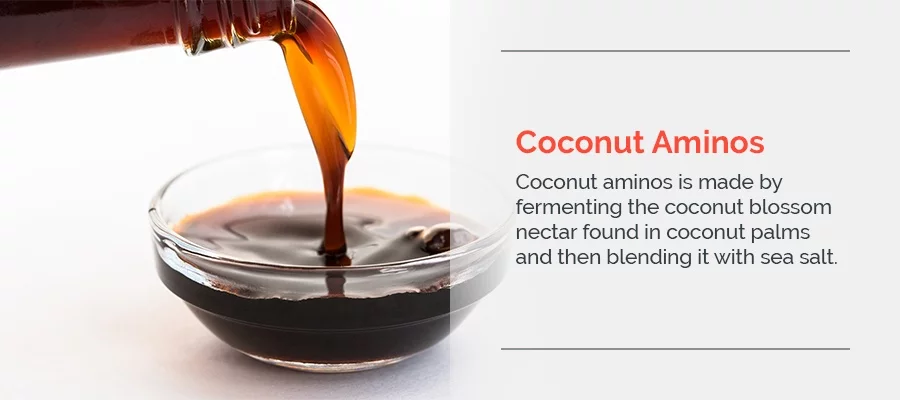
1. Coconut Aminos
Coconut aminos is made by fermenting the coconut blossom nectar found in coconut palms and then blending it with sea salt. Although similar to soy sauce, coconut aminos tends to be a bit thinner and sweeter than traditional soy sauces.
Because the sauce comes from coconut palms and doesn’t contain any wheat, coconut aminos is naturally gluten-free. As a bonus, coconut aminos doesn’t contain any soy either, making it compatible with a paleo or Whole30 diet. People looking to minimize their salt intake will also love coconut aminos because it contains less sodium than most soy sauces.
2. Liquid Aminos
Liquid aminos is another gluten-free soy sauce alternative. Liquid aminos is a liquid protein concentrate that comes from soybeans but is not fermented. Overall, liquid aminos has a more intense taste than soy sauce with a bit of a smoky kick. You can use liquid aminos the same way you would use regular soy sauce to add another layer of flavor to dishes and brighten up a meal. However, look for a label for a serving size and its sodium content as it can contain more sodium than most soy sauces.
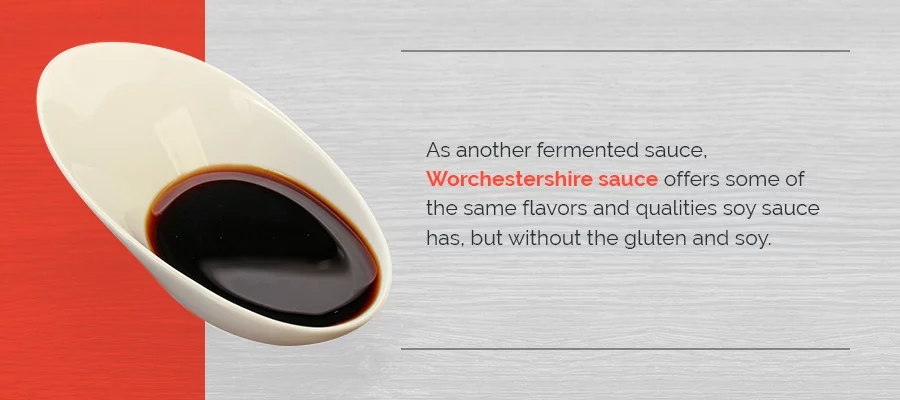
3. Worcestershire Sauce
Craving that umami flavor but don’t want to use soy sauce? Worcestershire sauce is a great substitute for taking your stir-fried vegetables or marinated meat up a notch. As another fermented sauce, Worcestershire sauce offers some of the same flavors and qualities soy sauce has, but without the gluten and soy. Worcestershire sauce also has considerably less sodium than soy sauce.
4. Fish Sauce
Fish sauce is made by fermenting fish or krill in salt for up to years at a time. This extended fermentation process produces a gluten-free sauce with a savory umami taste that is similar to soy sauce, but with a slight fishy taste. Because fish sauce naturally has a fishy quality, and contains more sodium, you will probably want to be cautious about substituting it for soy sauce in equal amounts. Instead of following a one-to-one ratio, slowly mix the fish sauce into a recipe, tasting as you go and adding more as needed.
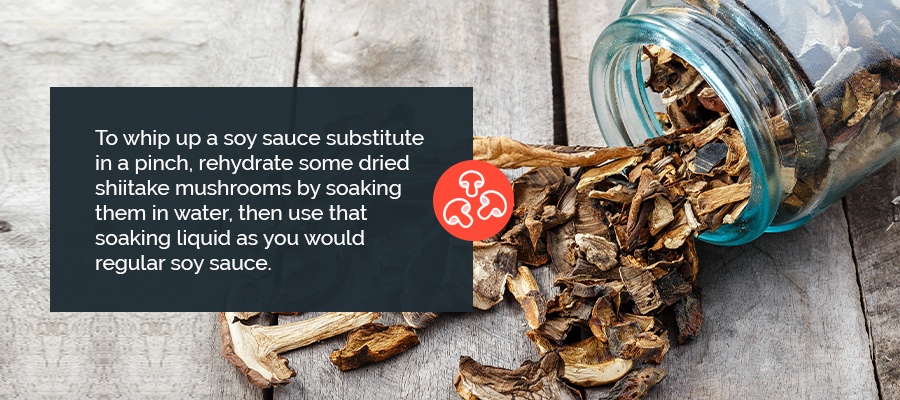
5. Dried Mushrooms
Dried shiitake mushrooms are another food rich in the savory goodness of umami, which makes them a great gluten-free, soy-free and low-sodium alternative to traditional soy sauce. To whip up a soy sauce substitute in a pinch, rehydrate some dried shiitake mushrooms by soaking them in water, then use that soaking liquid as you would regular soy sauce.
Although this culinary solution doesn’t resemble soy sauce quite as closely as some of the other substitutes, it will deliver a distinct umami flavor.
Gluten-Free Tamari Soy Sauce From SAN-J
If you’re looking for a soy sauce that’s reliably gluten-free and full of flavor, try using SAN-J Tamari Soy Sauce to enhance your next snack or meal. Our premium soy sauce is brewed with 100% soy and no wheat. We put only the finest umami ingredients into our Tamari Soy Sauce and follow a unique family formula that’s been passed down from generation to generation for over 200 years.
Find out how delicious gluten-free soy sauce can be when you use SAN-J Tamari Soy Sauce today.
Back to Top

